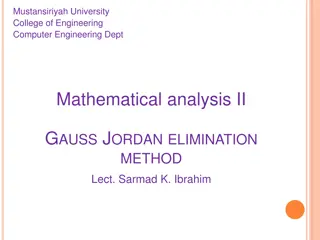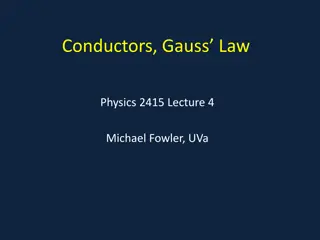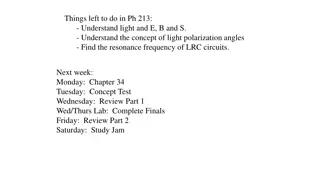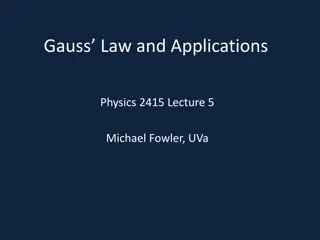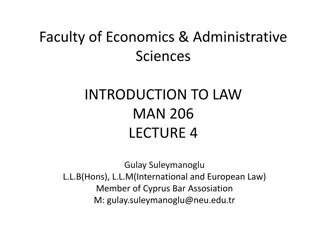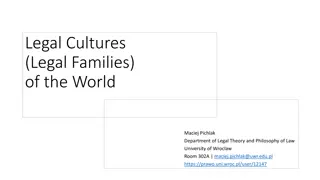
Understanding Electric Field and Gauss's Law Applications
Explore the applications of Gauss's Law in determining electric fields due to uniformly charged spheres and cylinders. Learn how to use Gaussian surfaces to find the electric field in various scenarios, such as spheres, cylinders, and infinite planes with uniform charge densities.
Download Presentation

Please find below an Image/Link to download the presentation.
The content on the website is provided AS IS for your information and personal use only. It may not be sold, licensed, or shared on other websites without obtaining consent from the author. If you encounter any issues during the download, it is possible that the publisher has removed the file from their server.
You are allowed to download the files provided on this website for personal or commercial use, subject to the condition that they are used lawfully. All files are the property of their respective owners.
The content on the website is provided AS IS for your information and personal use only. It may not be sold, licensed, or shared on other websites without obtaining consent from the author.
E N D
Presentation Transcript
Applications of Gausss Law:- i) Electric field due to uniform charged sphere:- Case I: To find the electric field outside a uniformly charged solid sphere of radius R.
Let the total charge be q and P be a point distance r from thecentre of the sphere. Draw a spherical Gaussian surface) of radius r as shown in fig. Now due to the spherical symmetry the field is perpendicular to the surface and has the same value atall points on the surface. By Gauss s law surface (called the
Let q be the charge enclosed within the Gaussian surface.
ii)Electric field due tocharged cylinder:- Consider a cylinder having an infinite length of radius R and having a uniform linear charge density symmetrical nature, perpendicular to the axis of the cylinder and will be directed away from it. The field has the same magnitude at equal distances from theaxis. . Due field to the be the will
To find the electric field at point P at a distance r from the axis, we consider a cylindrical Gaussian surface of radius r and co-axial with the charged cylinder. The two end faces of the cylinder are perpendicular to the axis. Therefore the electric field being tangent to these surfaces will be zero.
Gaussian Pillbox:- To find the electric field due to infinite plane which carries uniform surface charge density . Consider a Gaussian pillbox extending equal distances above and below the plane.
Poissons Equations:- Poisson s equation is the fundamental differential equations satisfied by the potential . We have the electric field is the negative gradient of the potential .
Laplaces Equation:- In the region where there is no free charge i.e. in charge free region, volume charge density =0; equation becomes so that poisson s
In order to avoid confusion we replace the scalar function by S. So Poisson s and Laplace s equation for scalar potential S cylindrical co-ordinates may bewritten as Poisson sequation:- in spherical and


